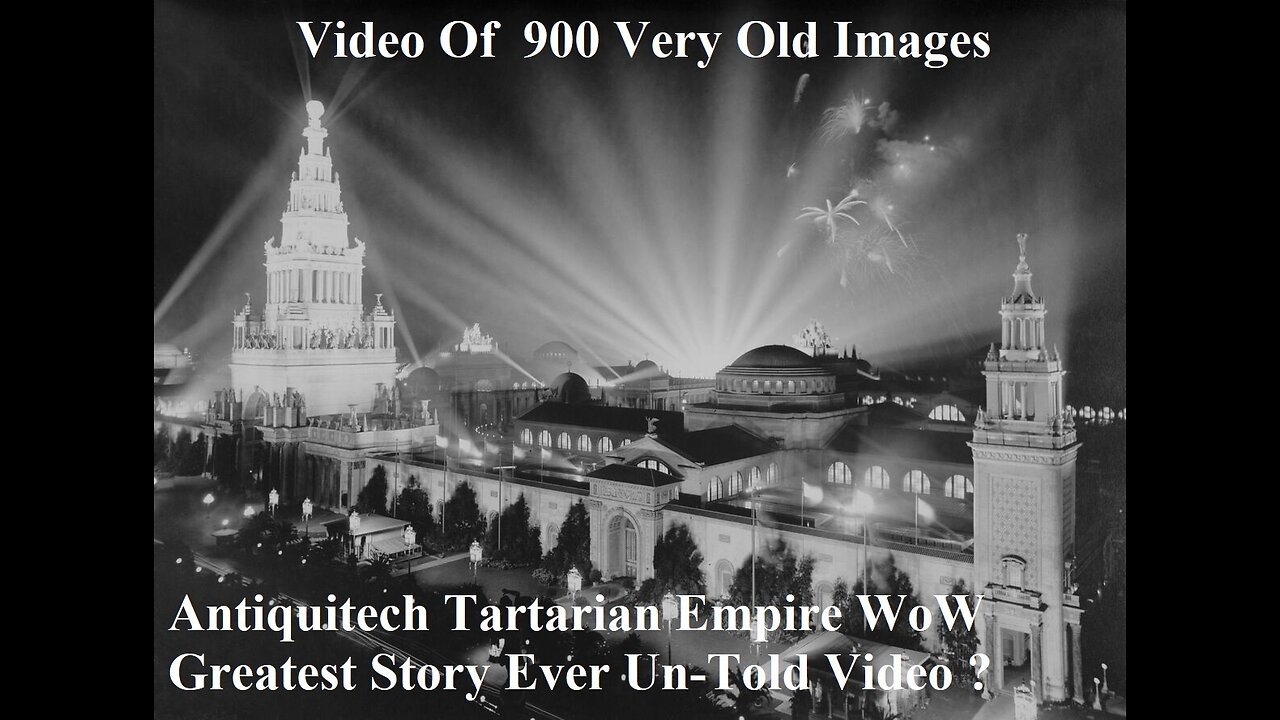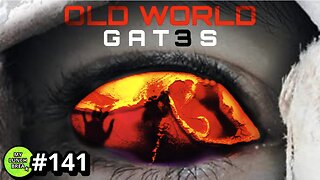Premium Only Content

Antiquitech Tartarian Empire Greatest Story Ever Un-Told Video Very Old 900 Images
Greatest Story Ever Un-Told 10 Parts Set and This 1893 World Columbian Exposition In Chicago Is Really A 1,000 Years Old City From Past Antiquitech Tartarian Empire and the True Believers in the “Tartaria” conspiracy theory that 100s of old world fairs 1801 thru 1940 era are convinced that the elaborate temporary fairgrounds built for events like the Panama-Pacific International Exposition in San Francisco in 1915 and 100s of other city were really the ancient capital cities of a fictional empire !
"Expositions are the timekeepers of progress. They record the world's advancement. They stimulate the energy, enterprise, and intellect of the people; and quicken human genius. They go into the home. They broaden and brighten the daily life of the people. They open mighty storehouses of information to the student. Every exposition, great or small, has helped to some onward step." President William McKinley, speaking at the 1901 Pan-American Exposition in Buffalo, NY.
The 1893 World Columbian Exposition in Chicago inaugurated an age of great fairs and expositions in the United States whose influence is felt to this day. The Chicago Exposition and the similar events that followed in Buffalo, NY; St. Louis, MO; Seattle, WA, San Francisco, CA and New York, NY dramatized technology and the fine arts, and illuminated the era ahead, as industrialism took hold, immigration peaked, science moved ever forward, and a vibrant, multi-faceted American music culture grew throughout the country.
Though the 1876 Philadelphia Centennial Exposition in Philadelphia had been a great success, the Chicago Exposition took its immediate inspiration from the Exposition Universelle held in Paris in 1889. Like all previous world's fairs, the Paris exposition hosted music and other entertainment among its exhibits, but in greater variety and on a much larger scale. A major work, Esclarmonde, was commissioned from French composer Jules Massenet and was performed nightly. Music from all over the world was heard, including Javanese gamelan, which was to have a profound effect on composer Claude Debussy. Fairgoers could also hear indigenous music at the village nègre, where some 400 Africans from European colonies spent the duration of the fair demonstrating their culture and crafts. A similarly conceived Algerian Village was also an attraction.
The organizers of the Chicago Exposition would try to match or outdo the 1889 Exposition in every way. For awhile, they even thought of creating a structure taller than the Eiffel Tower built for the 1889 fair, and the tallest building in the world at the time. In the end, they settled for a spectacular city-within-a-city that sprawled over 600 acres and featured 65,000 exhibits. "The White City," so named for its many white buidlings that were made even brighter by the night-time illumination supplied by General Electric, captured the imagination of the country, and drew over 27 million paying customers during its run from May 1st to October 30th, 1893. Within its walls, fairgoers could marvel at the ever-multiplying technological wonders of the age, enjoy art exhibits, concerts and sports; listen to lectures on various topics, view short films in the world's first dedicated movie theater, or ride the original Ferris Wheel.
The Ferris Wheel loomed over the portion of the grounds billed as the "Midway Plaisance," or simply "the Midway," a sort of outdoor arcade 220 yards across that stretched for a mile outside the main fairgrounds in Jackson Park, where rides, music, food, amusements and sideshows of every description were on offer. The "Street in Cairo" exhibit was the most popular of all, drawing more than two million customers to see the first American display of Middle Eastern belly-dancing.
Inside the ‘Tartarian Empire,’ the QAnon of Architecture
On YouTube videos and Reddit boards, adherents of a bizarre conspiracy theory argue that everything you know about the history of architecture is wrong.
In 1908, architect Ernest Flagg completed the Singer Building in Lower Manhattan, a Beaux-Arts showstopper made for the Singer sewing machine company. From a wide base, a slender 27-story tower rose, topped by a mansard roof and a delicate lantern spire.
Every inch dripped with sumptuous detail inside and out; vaulted roofs, marble columns with bronze trim, window mullions with spiral fluting. The lobby was said to have a “celestial radiance.” A book was written just about its construction. For a year, it was the tallest building in the world at 612 feet, and a celebrated landmark for decades after that.
But not for too much longer. Despite its great height, the pencil-thin tower lacked office space. In the 1960s the company sold its ornate headquarters; demolition proceeded in 1967. It’s the tallest building to ever be peacefully demolished.
By any account, it’s a fantastical tale: Once the tallest building in the world and a New York icon, knocked down in just a handful of decades.
For some, it’s too fantastical to believe … or perhaps not fantastical enough. A dedicated group of YouTubers and Reddit posters see the Singer Building and countless other discarded pre-modern beauties and extant Beaux-Arts landmarks as artifacts of a globe-spanning civilization called the Tartarian Empire, which was somehow erased from the history books. Adherents of this theory believe these buildings to be the keys to a hidden past, clandestinely obscured by malevolent actors.
Who? Why? To what possible end? As in many other, more high-profile conspiracy theories, this baroque fantasy doesn’t offer much in the way of practical considerations, logic or evidence. But it’s grounded in some real anxieties, pointing toward the changes wrought by the modern world in general and modern architecture specifically — and rejecting both.
Tartaria rises
Tartarian-themed content is produced for YouTube videos that get picked over on Reddit. The r/Tartarianarchitecture sub, which began in December 2018, has 3,300 members, though not everyone who posts and comments appears to be a true believer. A larger and more general sub that appeared around the same time, r/Tartaria, has 8,700 members. As conspiracy theories go, Tartaria remains obscure; Twitter user cinemashoebox brought it to many people’s attention last year with this thread, and pseudoscience-debunking writer Brian Dunning recently devoted an episode of his podcast, Skeptoid, to the Tartaria theory, which appears to have first emerged in 2016 and 2017.
The Tartaria storyline is not directly related to the adrenochrome-harvesting Satanic-pedophile cabal that lies at the heart of QAnon, the unfounded conspiracy theory that crashed into the real world in 2020. But it shares some of what Peter Ditto, a social psychologist at the University of California-Irvine who specializes in conspiracy theories, calls QAnon’s “cafeteria quality:” There’s no overarching narrative or single authorial voice interpreting events. It’s just a gusher of outlandish speculation; adherents can pick and choose which elements they want to sign on to.
The overall premise is an alternative history. A vast, technologically advanced “Tartarian” empire, emanating from north-central Asia or thereabouts, either influenced or built vast cities and infrastructure all over the world. (Tartaria, or Tartary, though never a coherent empire, was indeed a general term for north-central Asia.) Either via a sudden cataclysm or a steady antagonistic decline — and perhaps as recently as 100 years ago — Tartaria fell. Its great buildings were buried, and its history was erased. After this “great reset,” the few surviving examples of Tartarian architecture were falsely recast as the work of contemporary builders who could never have executed buildings of such grace and beauty, and subjected them to clumsy alterations.
“I think that it was one worldwide civilization,” says Joachim Skaar, a 26-year-old Norwegian who runs The Tartarian Meltdown YouTube channel. “It was all based on unity, oneness, peace, love, and harmony, which we don’t see in today’s society.”
There’s an arch-traditionalism present in the theory, too. The pre-modern buildings that we venerate are sometimes said to be more than 1,000 years old. “The same people that built the Capitol in Washington built the pyramids in Egypt,” Skaar says.
Reached at his recording studio, Skaar, who works as a plumber, is not an architect or historian, but he has strong opinions on both disciplines. “We have two very different types of architecture,” he says. There’s modern architecture “with the name Brutalism,” which he describes as “square concrete boxes which are designed to be produced very fast, very cheap and very effective.”
And then there’s Tartarian architecture, a label that gets applied to anything that’s particularly ornate and pre-modern, encompassing many Western styles: Classical, Beaux-Arts, Second Empire. The term is also sometimes used for some non-Western structures, like the Taj Mahal. Structures that seem geographically or culturally dislocated, like the Beaux-Arts commercial buildings in Shanghai’s Bund district, are particularly attractive to this theory, as are those that are impressively massive, like the pyramids of Egypt or the Great Wall of China (built, the theory goes, by Tartarians to keep the Chinese out). Anywhere there’s a perceived gap between the refined craftwork of an old building and the “primitive” technology of the horse-and-buggy-era people building it, space for Tartarian speculation pops up.
American cities of the 19th century are often rich with Tartarian appropriation, especially the young settlements of the West, when grand public structures seemed to emerge from the wilderness, surrounded by wood hovels and muddy streets. State capitol buildings and city halls are frequently fingered as palaces of ancient Tartaria rather than Gilded Age municipal buildings. (These photos of the Iowa State Capitol in Des Moines highlight the contrast Tartarian theorists point out.)
The Tartarian milieu is an intensely visual medium, occupied with riffing on photos and maps, picking out apparent inconsistencies and making one-off conjectures instead of weaving together comprehensive timelines. The theory is notably light on reasoning as to why and how the greatest cover-up in history was undertaken, but it does offer a few options for how Tartaria was erased and the great reset propagated. Many say that an apocalyptic mud flood buried its great buildings; some suggest the use of high-tech weaponry to tactically remove Tartarian infrastructure. A consistent theme is that warfare is an often-used pretext to wipe away surviving traces of Tartarian civilization, with the two world wars of the 20th century finishing work that may have begun with Napoleon’s invasion of Russia.
Despite their interest in architecture, most Tartaria theorists do not appear to have backgrounds in the building trades: Many of the more easily refuted arguments spring from very basic misunderstandings of how the built environment works, as well as broader confusion about how buildings function in the economy and culture. An abundance of posters appear convinced that below-grade basement windows in older buildings, for example, are evidence that the building had been “mud flooded,” and the rest of the structure is actually buried deep underground. Sometimes this will get some skeptical pushback (“I think they didn't have lights in the cellar so they build in windows for them?” was how one poster responded), but that’s more of an exception than the rule.
“You see these capital domes all over the world, which, to me, proves that the same people built everywhere.”
Similarly, their grasp of historic labor and material costs is shaky. Before the Industrial Revolution, labor was cheap, so paying artisans to sculpt elaborate masonry — even for relatively humble structures — wasn’t the great expense it seems today, when labor prices are higher and factory-made steel, concrete and glass is cheap; that’s why we see so much of these materials in buildings today, and so much less filigreed terra cotta. One of the most adamant denials in Tartarian circles is that public buildings like schools and post offices were ever built with monumental proportions and elegant aesthetics. They sneer at the wedding-cake-topper Second Empire buildings designed by Alfred Mullett after the Civil War, for example. “How many stamps did you sell to build yourself a post office like this?,” says popular Tartarian YouTuber JonLevi in one of his videos. “Absolutely ridiculous. The post office has always struggled.” (He has more than 100,000 subscribers.)
Some of this confusion is unfamiliarity: Mullett’s U.S. Customs House and Post Office in St. Louis, for example, was a huge federal project, built to process the mail of 10 states and four U.S. territories, not a neighborhood letter depot. But beyond that, there’s a broader refusal to believe that public architecture could ever have been built in an atmosphere of generosity and abundance. This is echoed by their astonishment at the double-height grand lobbies and arched doorways of old buildings, which they see as artifacts not meant for us. (Some theorists surmise that ancient Tartarians were giants.) The Tartarian community seems to have internalized the current era’s predilection for public sector austerity and the resulting aesthetics, which they abhor, more than they realize.
At its core, the theory reflects a fear of how quickly things change. As they look at today’s cityscapes, Tartaria believers see an eerie and alienating place, filled with abstract monoliths that emerged out of nowhere in a brief period of time. They’re skeptical of the rapid rise and development of the U.S., and even more suspicious of how quickly Modernism came to dominate the landscape. One favorite case study, useful for illustrating this aesthetic whiplash, is the grand domed Henry Ives Cobb Chicago Federal Building, built in 1905. Like the Singer Building, it was razed after just 60 years in favor of an icy black Mies van Der Rohe tower.
In one sense, the Tartaria theory is right: With modern architecture, a revolutionary new consensus on how the built environment should look and work did take hold in a very short period of time, conveniently overlapping with the world wars that these theorists see as the tail end of Tartaria’s influence. The world of 1960 indeed looked radically different from the world of 1920. Led by obscure and poorly understood forces (architects), architecture schools truly did throw out the history books to build a new world. But instead of making this excision the work of a colossal global mega-conspiracy worthy of a pulpy airport mystery novel, they wouldn’t shut up about it.
In the Tartarian worldview, we’re a society that doesn’t properly understand or value the built environment, because we’ve been misled about who really built it. When he’s decrying the lack of regard for the cultural legacy of old buildings, Skaar sounds less like a conspiracy theorist than a board member of a preservation nonprofit. “The problem is that people don’t recognize these buildings,” he says. “They walk past them all the time, and they’re fascinated, but they don’t think any more deeply about it. They don’t know what they’re looking at because they have been told something else.”
In search of a fabricated empire
This disregard for architecture’s “true” history moves into a wider rejection of how disposably cheap and commodified the culture at large seems to be. As such, one canonical belief of Tartarian aficionados is that the elaborate temporary pavilions built for late 19th century and early 20th century World’s Fairs were in fact Tartarian capital cities. It strikes them as improbably wasteful that anyone would erect these magnificent complexes, full of fluted columns, domes and pediments, out of plaster of Paris, hemp fiber, and straw, as was done for the 1893 World’s Fair in Chicago. In Tartarian lore, these sites were ancient monuments that were co-opted to teach a falsified history of the world and make a few bucks selling popcorn and Ferris Wheel rides. Then they were demolished, to erase the handiwork of the real builders.
In pointing out the eradication of an ancient culture by an expanding imperial power, Tartarian believers again stumble on something real, but they scramble the protagonists. In the European colonial era, Western nations fanned out over the globe, subjugating and destabilizing numerous non-white civilizations — and building many examples of what’s now considered Tartarian architecture as celebration of these victories. But when YouTuber JonLevi marvels at the Hong Kong Shanghai Bank and the rest of the 1920s banking infrastructure built along Shanghai’s Huangpu River, he doesn’t see the wealth-extracting handiwork of a rapacious 20th century empire: In the Tartaria-verse, these are the stately remnants of a far older and more benevolent one. The theory posits that only Tartarians, not British bankers or Belgian rubber barons, could move culture like architecture across geography.
“You see these capital domes all over the world, which, to me, proves that the same people built everywhere,” says Skaar.
Bastion star forts are another building type that Tartarians are obsessed with: They often point out that these cannon-resistant military fortifications, popular in the 16th and 17th centuries, are found all over Western Europe, like Portugal and the Netherlands, but also quite mysteriously, far away in Asia, in Sri Lanka. But since Sri Lanka was a Portuguese and Dutch colony, it’s not really very mysterious. Military historian Jeremy Black, author of two books on the history of fortifications, says that the geographic reoccurrence of the style reflects how effective Europeans were in spreading this technology across the globe.
This ahistoricism can make the Tartarian architecture community occasionally receptive to reactionaries, racists and anti-Semites. A survey of videos and discussions will turn up all manner of other conspiratorial threads. Along with flat-Earth advocacy, anti-vaccination sentiments and 5G scaremongering, there’s talk of anti-Semitic banking cartel conspiracies and Holocaust denial. Some Tartarian histories recast populations of Central Asia, like Genghis Kahn’s Mongol Empire, as red-haired, blue-eyed, white people — “Silk Road Aryans.”
The persistence of anti-Jewish tropes within current conspiracy theories is likely the result of cultural inertia, says UC-Irvine scholar Ditto. As successive generations of the conspiracy-minded seek evidence to back up their diverging worldview, they find it in texts that may go back centuries, which are riddled with anti-Semitism.
But the face of the villains in the Tartarian narrative is not clearly defined. Skaar blames quasi-mystical “parasites” who thrive off pain and strife, and laments that contemporary life has become a place where “everything is based on tyranny, greed, and slavery.” The Tartaria commentariat is laced with economic discontent; they often decry the evaluation and disregard of buildings purely as salable commodities, untethered from broader notions of cultural legacy and achievement. There’s a reoccurring and implicit understanding that buildings, like the Singer Building, get torn down when they stop making money — the only thing that really matters — and that the world is a vast field of predation, where the rich and powerful consume the poor and weak.
In fact, the governing ideology of the modern architecture that Tartarians despise was a critique of this system. Modernism argued for an egalitarian architecture that would help break the shackles of the past, rejecting backbreaking representational craftsmanship to honor omnipotent kings and divine beings in favor of simple, universal forms that would leverage restraint and efficacy into a broad uplift for the masses. Minus the weirdest stuff — the global mud flood, the ancient energy weapons, the vanished race of giants — the Tartaria theory is just an extreme form of aesthetic moralism, the idea that traditional architecture styles are inherently good and modern architecture is the product of a degenerate culture.
The tastes of the community generally align with traditional architectural revival proponents (some of whom also embrace reactionary and white nationalist politics). This sort of aesthetic nativism flourished during the Trump era, and it appears to have fresh converts in Congress: Recently, representatives Marjorie Taylor Greene and Paul Gosar formed a new caucus dedicated to “uniquely Anglo-Saxon political traditions” and infrastructure that “befits the progeny of European architecture.” The language is different, but the sentiment wouldn’t appear out of place in r/Tartaria.
Holding back a flood of conspiracies
Though the Tartarian Empire seemed to wink into existence in the past few years, the themes its believers explore are familiar ones. Conspiracy theories are a way to channel restive populism in the face of rapid social and demographic change, Ditto says, and there’s plenty of that going around. They are also a way to gather up amorphous fears and put them in a specific place, to make them more manageable. Ditto calls this “over-intentionalization.
“If your fate is controlled by impersonal, systemic forces, it doesn’t offer you much control over your own destiny,” he says. “But if you can localize it to a small group of people whose motives you understand — they are out to get you — then it at least offers some hope that you can overcome their malevolent intentions.”
Belief in conspiracy theories can also be driven by loneliness, isolation and economic hardship, which made a pandemic a fertile Petri dish, and helped QAnon’s believers storm the Capitol by force and through the ballot box. The social atomization forced on us by Covid-19 is a hyperbolic retelling of the Tower of Babel (which has a special place in Tartarian lore) and its attendant anxiety at fracturing and divided cultures. The great reset that erased that tower — and the fabulous, fictional empire that built it — continues to reverberate, splintering us into ever-stranger factions.
And Ditto says it does seem like reality is getting harder to decipher. The internet has made it easier to disseminate misinformation while eroding faith in the media hierarchies that once filtered it out. Polarization and a lack of trust in government and institutions creates a feedback loop, where leaders can’t solve problems because their political bases are too narrow, and the resulting failures engender more distrust. It’s not a new cycle — despite a spike in media attention, there’s not much evidence that conspiratorial thinking is more common now than in years past — but technology can make these currents of collective delusion more powerful, and harder to ignore.
The basic human desires for community, stories (the more outrageous the better) and the need to feel like a protagonist in a wider struggle are what pulls us from moments of real social, economic and cultural dislocation into fabricated histories. Buildings and cities are made to grow old, to outlast people, and to be a testament to these cultural histories. They’re a yardstick for a culture’s ability to endure. When they’re not given the chance to do this, the contradiction can break something loose, and send people scavenging for cultural memory that feels ancient enough to anchor them in an uncertain now.
This is a chronological list of international or colonial world's fairs.
https://en.wikipedia.org/wiki/List_of_world's_fairs
All elaborate temporary fairgrounds built are removed after the fair is over.
GREATEST STORY - Part 1 - Our Journey Begins – 0 Mins 16 Sec.
https://www.bitchute.com/
The secret is out, thanks to people like Michelle Gibson and Jon Levi. The more you delve into history and understand the required technology to build the infrastructure and buildings of the past, the more you realize we are missing part of the story - The Greatest Story. Just who did all this work and what happened to them? Who now controls us and makes us pay for energy that once was free? This series includes various composition styles and historical subjects, together with music gear explanations used.
GREATEST STORY - Part 2 – Ruthless – 3 Mins 50 Sec.
https://www.bitchute.com/
There are so many anomolies during the 1800s and early 1900s, whereas this video selects only a few and how ruthless the 'controllers' are in hiding our true history. FYI... when you see that giant ferris wheel, keep in mind that the axle alone weighed over 90,000 pounds and was so thick of steell that they could not cut it up and destroy it... it was buried under a golf course.
GREATEST STORY - Part 3 -Strange Days – 0 Mins 27 Sec.
https://www.bitchute.com/
Has there ever been a stranger time than the 1800s (early 1900s), with massive buildings of similar styles found world-wide, photographs of odd people, customs and animals?
GREATEST STORY - Part 3A -Strange Days – 5 Mins 41 Sec.
https://www.bitchute.com/
Has there ever been a stranger time than the 1800s (early 1900s), with massive buildings of similar styles found world-wide, photographs of odd people, customs and animals?
GREATEST STORY - Part 4 - Paradise Lost – 2 Mins 41 Sec.
https://www.bitchute.com/
In two years, this is what was built with horse, oxen, shovels and wheelbarrows... LOL. It would take that long just to create the canal system and get all the land landscaped, not to mention pouring the foundations and footings, etc., etc. And all that just to tear it down after a few months of viewing. Even the 'build' photos are suspect. Let me know when it makes sense. Welcome to the Chicago's World Fair 1893.
GREATEST STORY - Part 5 - Boer War – 3 Mins 00 Sec.
https://www.bitchute.com/
With photography and film around at the time of the Boer War, why do we not have any official footage or pictures of battles; rather, we get reinactments. And how curious that wonderous architecture was around in Africa prior to this war even taking place.
GREATEST STORY - Part 6 - The Way It Should Be – 2 Mins 55 Sec.
https://www.bitchute.com/
At one time the world was beautiful, and the architecture so uniform from one country to the next, that it had to have been created by the same people, living harmoniously. Today, architecture is mostly bland, box-like and consistnig of materials that won't last (a lot of steel framing and glass). We couldn't replicate the building of the past even if we wanted to.
GREATEST STORY - Part 7 - Guatemalan Facade – 2 Mins 51 Sec.
https://www.bitchute.com/
No matter where you go in the world, there are buildings that have the same characteristics and from the same timeline. Guatemala is no exception. It may be Central America, but it the architecture is no different than Europe, Australia, South America or the United States. Something very 'common' happened world-wide and during a particular time.
GREATEST STORY - Part 8 - Most Beautiful – 2 Mins 10 Sec.
https://www.bitchute.com/
There literally are hundreds of amazing architectural wonders, whereas this is a very small sample. The sheer beauty and unobtainable structures tells us the people of the past were not simple, and any claims that some of these were built in the mid 1800s to early 1900s is hogwash and a deception of our timeline and who we were (and what we were cable of, with horse, wagon, shovel and hammer).
GREATEST STORY - Part 9 - Time Shifters – 8 Mins 59 Sec.
https://www.bitchute.com/
Something happened during our timeline. This video broaches some of the events and individuals that may have played a role.
GREATEST STORY - Part 10 - The Inheritors – 3 Mins 13 Sec.
https://www.bitchute.com/
Something very odd appears within the mid to late 1800s - a people unskilled to create the world as we knew it (and see it in photographs). They not only look out of place, relative to the majesty and beauty, but 'floods' of people in certain situations occurred, but immigration to baby incubators at trade shows.
GREATEST STORY - Part 11 – Homecoming – 3 Mins 25 Sec.
https://www.bitchute.com/
I grew up in a small city in Northern Ontario, but when it was nothing more than a town, there was (and still is) some very interesting and overbuilt structures for such a small population. Research your own town/city and ask: "are these structures appropriate for the times and people, and could they have built those structure with the people and resources of the time?"
GREATEST STORY - Part 12 - Cabinet of Curiosities – 5 Mins 46 Sec.
https://www.bitchute.com/
A few very interesting artifacts, photos and more that suggest our timeline is not what we have been told.
GREATEST STORY - Part 13 - Free Energy – 5 Mins 10 Sec.
https://www.bitchute.com/
Technology to harness energy has existed far longer and before Nicola Tesla (who like reversed engineered what already was around).
GREATEST STORY - Part 14 - Mud Flood – 2 Mins 46 Sec.
https://www.bitchute.com/
Nearly every modern civilization is built upon another. And some past civilization are built upon others still. A fascinating mystery that suggests many parts of the world are older than we realize, or that there has been multiple resets and destruction.
GREATEST STORY - Part 15 - Bullshit Train – 1 Mins 46 Sec.
https://www.bitchute.com/
Do you really think that most railroad tracks and the entire infrastructure was built in only 20-30 years across North America? Or were much of the structure excavated from a previous people?
GREATEST STORY - Part 16 - Question His Story – 3 Mins 29 Sec.
https://www.bitchute.com/
There are far too many anomalies in world history; this video takes a glimpse at Mount Rushmore and the USA road/highway system. I could be wrong on these aspects, but...
GREATEST STORY - Part 17 – Havoc – 2 Mins 54 Sec.
https://www.bitchute.com/
Ancient tech abound. How many things can you spot that most likely was carved or made of wood that petrified?
GREATEST STORY - Part 18 – Yesteryear – 2 Mins 45 Sec.
https://www.bitchute.com/
The glorious structures of India in early photos appears to be a blend of Tartarian, Moorish and Turkish, creating some of the most mysterious and detailed buildings (and those highly carved walls likely were wood that later petrified or was put through a 'rock' or hardening process). Please consider supporting this channel with any amount you wish, and thank you.
GREATEST STORY - Part 19 - Galveston... Oh... Galveston – 2 Mins 30 Sec.
https://www.bitchute.com/
Glen Campbell was fond of Gavelston, and this place certainly had a lot going for it, more than any other city in the USA during its time. A sliver of an island, yet strategically built and considered by the people at the time. Thanks to Jarid Boosters' channel for compiling the time-line info and many photos.
GREATEST STORY - Part 20 - Tech Lords – 3 Mins 20 Sec.
https://www.bitchute.com/
Here is far too much information that will blow your mind, and so... I selected only a few examples of past history tech I find impressive. More such videos to come.
GREATEST STORY - Part 21 - Can't Judge a Book by Its Cover – 3 Mins 35 Sec.
https://www.bitchute.com/
There is far too much information that will blow your mind, and so... I selected only a few examples of past history tech I find impressive. More such videos to come.
GREATEST STORY - Part 22 - In the Swamp – 2 Mins 50 Sec.
https://www.bitchute.com/
Let's take a look at Louisiana, known for the Bayou, jazz, Mardi Gras, spicy foods... and perhaps... a bit more that seems to conflict with what the historical narrative suggests.
GREATEST STORY - Part 23- Civil Warp – 3 Mins 12 Sec.
https://www.bitchute.com/
Music by Me and based on historical fiction ?. Certainly people died and there may have been actual battles. But the reason for this war (initiated by the Roths) may have been more elaborate and for reasons of destruction. A touch of humor at the end.
GREATEST STORY - Part 24 - Impossible Dream – 3 Mins 45 Sec.
https://www.bitchute.com/
Dream the impossible dream - all 'built' not long ago, between 1885-1900. Yes, I've had professionals in the areas of architecture and stone masonry, and they agree that they have no idea how to rebuild any of this. No blueprints exist. Who built them? Let's take a trip around the world and look at some fabulous structures! Of course, this is all a work of fiction .
GREATEST STORY - Part 25 - Mind Fudge (Pt. 1) – 7 Mins 28 Sec.
https://www.bitchute.com/
GREATEST STORY - Part 26 - Mind Fudge (Part 2) – 5 Mins 54 Sec.
https://www.bitchute.com/
GREATEST STORY - Part 27 - Head in the Clouds – 2 Mins 43 Sec.
https://www.bitchute.com/
Something is happening with our world and atmosphere, whether from microwave pollution, 'kem' trails, pollution or another warning of a future reset.
GREATEST STORY - Part 28 - Where Did All the People Go q – 11 Mins 05 Sec.
https://www.bitchute.com/
It may be eerie to see few people around walking or with horse and cart, but nothing compared to cities that are nearly vacant or totally vacant, but why? Where are all the people if these major cities and locations have been populated for hundreds or thousands of years (according to the narrative)? What happened prior to these photos, all taken around the mid 1800s?
GREATEST STORY - Part 29 - Everywhere a Castle – 3 Mins 56 Sec.
https://www.bitchute.com/
If anything, the world is consistent; no one in any country has a clue how to rebuild the castles found in their own countries.
GREATEST STORY - Part 30 - Ready... Reset... Go – 8 Mins 48 Sec.
https://www.bitchute.com/
A hypothetical look at when and how the Resets may have come about.
GREATEST STORY - Part 31 - Feast for the Eyes – 13 Mins 08 Sec.
https://www.bitchute.com/
GREATEST STORY - Part 32 - Rewriting History – 0 Mins 51 Sec.
https://www.bitchute.com/
GREATEST STORY - Part 32A - Rewriting History – 17 Mins 58 Sec.
https://www.bitchute.com/
GREATEST STORY - Part 33 – Fasces – 2 Mins 18 Sec.
https://www.bitchute.com/
GREATEST STORY - Part 34 - Post-Reset Postcards – 0 Mins 44 Sec.
https://www.bitchute.com/
A look into the past with various vintage postcards showing old-world architecture, but also art heavily influenced by the Phoenicians.
GREATEST STORY - Part 35 - Rise Up – 0 Mins 34 Sec.
https://www.bitchute.com/
Everything is connected, from the destruction of history to controlling the narrative with the current world-wide situation. Wake up and rise up!
GREATEST STORY - Part 35A - Rise Up – 3 Mins 27 Sec.
https://www.bitchute.com/
Everything is connected, from the destruction of history to controlling the narrative with the current world-wide situation. Wake up and rise up!
GREATEST STORY - Part 36 - Let There Be Light – 6 Mins 23 Sec.
https://www.bitchute.com/
The timeline seems off... we were told electricity was invented around 1891, by Tesla. However, there were world fairs, opera houses and estates of the elite that had power well before that. It seems the controllers and elite had access to past technology that they kept from the rest of us slobs.
Real Timeline Of Deception Part 0 Exploring Tartaria 1000 Years
Exploring Tartaria - Old World Secrets Revealed
https://rumble.com/v2u8ef4-real-timeline-of-deception-part-0-exploring-tartaria-1000-years-added-to-ou.html
Real Timeline Of Deception Part 1 Exploring Tartaria 1000 Years
The Timeline Deception - Part I - Exploring Tartaria
https://rumble.com/v2ua8sa-real-timeline-of-deception-part-1-exploring-tartaria-1000-years-added-to-ou.html
Real Timeline Of Deception Part 2 Exploring Tartaria 1000 Years
The Timeline Deception - Part II - Exploring Tartaria
https://rumble.com/v2ubf4w-real-timeline-of-deception-part-2-exploring-tartaria-1000-years-added-to-ou.html
Real Timeline Of Deception Part 3 Exploring Tartaria 1000 Years
The King of Tartaria - Exploring Tartaria
https://rumble.com/v2ueih6-real-timeline-of-deception-part-3-exploring-tartaria-1000-years-added-to-ou.html
Real Timeline Of Deception Part 4 Exploring Tartaria 1000 Years
The Saints - Relics, Reliquaries, & The First Resurrection
https://rumble.com/v2ugl92-real-timeline-of-deception-part-4-exploring-tartaria-1000-years-added-to-ou.html
Real Timeline Of Deception Part 5 Exploring Tartaria 1000 Years
The Saints - The Ruling Class - Exploring Tartaria
https://rumble.com/v2uij7w-real-timeline-of-deception-part-5-exploring-tartaria-1000-years-added-to-ou.html
Real Timeline Of Deception Part 6 Exploring Tartaria 1000 Years
From Atheism, Agnosticism, New Age, Protestantism, to Roman Catholicism
https://rumble.com/v2ujvr6-real-timeline-of-deception-part-6-exploring-tartaria-1000-years-added-to-ou.html
Real Timeline Of Deception Part 7 Exploring Tartaria 1000 Years
The Millennial Kingdom of God - Exploring Tartaria
https://rumble.com/v2uldss-real-timeline-of-deception-part-7-exploring-tartaria-1000-years-added-to-ou.html
Real Timeline Of Deception Part 8 Exploring Tartaria 1000 Years
Magic of the White City 1893 Chicago World's Fair
https://rumble.com/v2un20g-real-timeline-of-deception-part-8-exploring-tartaria-1000-years-added-to-ou.html
Real Timeline Of Deception Part 9 Exploring Tartaria 1000 Years
1000 Years Added To Our History & Dark Ages Never Existed
https://rumble.com/v2uo07i-real-timeline-of-deception-part-9-exploring-tartaria-1000-years-added-to-ou.html
Real Timeline Of Deception Part 10 Exploring Tartaria 1000 Years
Church History - Complete Documentary AD 33 to Present
https://rumble.com/v2uprfu-real-timeline-of-deception-part-10-exploring-tartaria-1000-years-added-to-o.html
Real Timeline Of Deception Part 11 Exploring Tartaria 1000 Years
Christmas Unveiled - Pied Piper - Templars Secret - Saturn's Workshop - Giants Stealing Children
https://rumble.com/v2urmd0-real-timeline-of-deception-part-11-exploring-tartaria-1000-years-added-to-o.html
Real Timeline Of Deception Part 12 Exploring Tartaria 1000 Years
Ancient Cloning Factories - Foundlings - Incubators - Test-Tube Babies
https://rumble.com/v2uu8ck-real-timeline-of-deception-part-12-exploring-tartaria-1000-years-added-to-o.html
Real Timeline Of Deception Part 13 Exploring Tartaria 1000 Years
Homunculus Unveiled - Jesus - Artificial Generation - Liber Vaccae - Lost Esoteric Secrets
Archaix Chronology Anunnaki Sumerian Gods Crystalinks Timelines 2040B.C. 2046A.D.
Archaix 2.0 Doomsday Chronology Five color charts with extensive Legend-chronology; exhibits 62 dates involving 300 events in linear timeline combining the Phoenix and Nemesis X Object appearances, the Mayan Long-Count baktuns and the Anunnaki NER 600 year periods, a history spanning over 74 centuries to May 2040 and November 2046.
The Lost History of Earth (Ewaranon) W0W - A Must See Video Lost Earth
Everything we were taught about the Earth, History, Science, Space, Energy and our Civilization was a lie. This mind blowing documentary will shift your perspective of the world monumentally.
The Secret Life of Symbols with Jordan Maxwell Knowledge of the Heavens, Life on Earth
Ancient Religions From Alpha To Stone Age To Omega To Modern Times To Infinity
This 11.5 Hrs. Full Documentary With Sound Is About Ancient Religions From Alpha To Stone Age To Omega To Modern Times To Infinity.
Everything we were taught about the Earth, History, Science, Space, Energy and our Civilization was a lie. This mind blowing documentary will shift your perspective of the world monumentally.
-
 11:54:57
11:54:57
What If Everything You Were Taught Was A Lie?
5 days agoThe Most Powerful Healing 432Hz + 963Hz + 528Hz Frequency Heal Damage In The Body And Spirit
1.53K1 -
 LIVE
LIVE
CassaiyanGaming
2 hours agoWARZONE PALOOZA - Rebirth with Cassaiyan, HannibalLecter, and DudeBroDude
92 watching -
 4:13:38
4:13:38
Akademiks
5 hours agoWar in RAT-LANTA. Young Thug vs Gunna vs Ralo vs YSL MONDO. Who Will Le Bebe Pick. FINAL CRASHOUT!
128K4 -
 21:55
21:55
MYLUNCHBREAK CHANNEL PAGE
1 day agoFault Lines are GATES - Pt 3
13.7K6 -

Sgt Wilky Plays
3 hours agoRumble Gaming Bad Company Presents WARZONEPALOOZA
8.22K -
 17:54
17:54
Nate The Lawyer
6 hours ago $1.88 earnedChicago Mayor’s $600M Migrant Spending Leaves City $1.1B Budget CRISIS.
13.1K26 -
 LIVE
LIVE
cosmicvandenim
16 hours agoVAN DENIM x RALLIED & GRITS | Team 6: Denim Grit | Warzonepalooza Tournament
212 watching -
 LIVE
LIVE
GamerGril
3 hours ago💕 The Evil Within 2 💕 | First Time Playthrough | Backseat Gaming Encouraged
66 watching -
 1:03:57
1:03:57
Jeff Ahern
3 hours ago $2.80 earnedThe Saturday show with Jeff Ahern
14.7K6 -
 LIVE
LIVE
ZWOGs
3 hours ago🔴LIVE IN 1440p! - Sgt Wilky's WARZONEPALOOZA - Warzone Resurgence Tournament - Come Hang Out!
52 watching